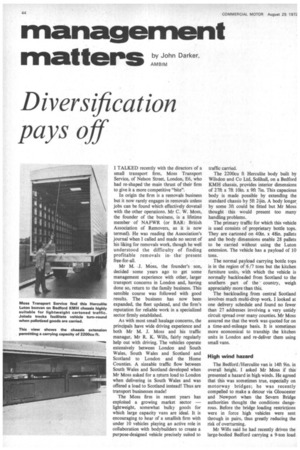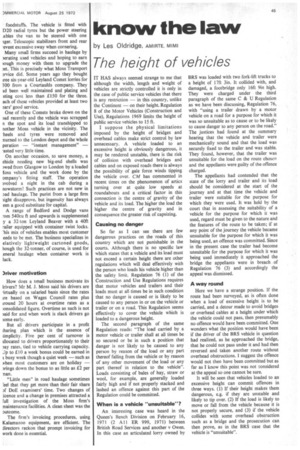management
Page 46

Page 47

If you've noticed an error in this article please click here to report it so we can fix it.
matters by John Darker
AMB M
Diversification pays off
I TALKED recently with the directors of a small transport firm, Moss Transport
Service, of Nelson Street, London, E6, who had re-shaped-the main thrust of their firm to give it a more competitive 'bite".
In origin the firm is a removals business but it now rarely engages in removals unless jobs can be found which effectively dovetail with the other operations. Mr C. W. Moss, the founder of the business, is a lifetime member of NAFWR (or BAR: British Association of Removers, as it is now termed). He was reading the Association's journal when I called and made no secret of his liking for removals work, though he well understood the difficulty of finding profitable removals in the present free-for-all.
Mr M. -J. Moss, the founder's son, decided some years ago to get some management experience with other, larger transport concerns in London and, having done so, return to the family business. This sensible course was followed with good results. The business has now been expanded, the fleet updated, and the firm's reputation for reliable work in a specialized sector firmly established.
As with most small haulage concerns, the principals have wide driving experience and both Mr M. J. Moss and his traffic manager, Mr R. K. Wills, fairly regularly help out with driving. The vehicles operate extensively between London and South Wales, South Wales and Scotland and Scotland to London and the Home Counties. A sizeable traffic flow between South Wales and Scotland developed when Mr Moss asked for a return load to London when delivering in South Wales and was offered a load to Scotland instead! Thus are transport businesses made!
The Moss firm in recent years has exploited a growing market sector — lightweight, somewhat bulky goods for which large capacity vans are ideal. It is encouraging to hear of a smallish firm with under 10 vehicles playing an active role in collaboration with bodybuilders to create a purpose-designed vehicle precisely suited to traffic carried.
The 2200cu ft Herculite body built by Wilsdon and Co Ltd, Solihull, on a Bedford KMH chassis, provides interior dimensions of 27ft x 7ft 10in. x 9ft 7in. This capacious body is made possible by extending the standard chassis by 5ft 2iin. A body longer by some 3ft could be fitted but Mr Moss thought this would present too many handling problems.
The primary traffic for which this vehicle is used consists of proprietary bottle tops. They are cat-toned on 40th. x 48in. pallets and the body dimensions enable 28 pallets to be carried without using the Luton extension. The vehicle has a payload of 10 tons.
The normal payload carrying bottle tops is in the region of '6 /7 tons but the kitchen furniture units, with which the vehicle is normally backloaded from Scotland to the southern part of the• country, weigh appreciably more than this.
The backloading from central Scotland involves much multi-drop work. I looked at one delivery schedule and found no fewer than 27 addresses involving a very untidy circuit spread over many counties. Mr Moss assured me that the work was quoted for on a time-and-mileage basis. It is sometimes more economical to tranship the kitchen units in London and re-deliver them using small vans.
High wind hazard The Bedford /Herculite van is 14ft 9in. in overall height. I asked Mr Moss if this presented a hazard in high winds. He agreed that this was sometimes true, especially on motorway bridges; he was recently compelled to make a detour via Gloucester and Newport when the Severn Bridge authorities thought the conditions dangerous. Before the bridge loading restrictions were in force high vehicles were sent through in pairs, thus greatly reducing the risk of overturning.
Mr Wills said he had recently driven the large-bodied Bedford carrying a 9-ton load
foodstuffs. The vehicle is fitted with D20 radial tyres but the power steering ables the van to be steered with one iger. Telescopic stabilizers front and rear .event excessive sway when cornering.
Many small firms succeed in haulage by nrating used vehicles and hoping to earn lough money with them to upgrade the bet.. This is precisely what Moss Transport rvice did. Some years ago they bought aree six-year-old Leyland Comet lorries for 500 from a Courtaulds company. They id been well maintained and plating and sting cost less than £150 for the three. aeh of these vehicles provided at least two 2ars' good service.
One of these Comets broke down on the tad recently and the vehicle was scrapped n the spot and its load transhipped to aother Moss vehicle in the vicinity. The heels and tyres were removed and :turned to the London depot and the whole peration — "instant management" — 'asted very little time.
On another occasion, to save money, a ehicle needing new big-end shells was rued from Glasgow to London by a loaded loss vehicle and the work done by the ompany's fitting staff. The operation 'volved a night in the cab during a nowstorm! Such practices are not new in )ad haulage. The purist from a large firm tight disapprove, but ingenuity has always een a good substitute for capital.
A range of Bedford and Dodge vans rom 540cu ft and upwards is supplemented y a 32-ton Leyland Beaver with a 40ft railer equipped with container twist locks. 'his mix of vehicles enables most customer eeds to be met. The business specializes in elatively lightweight cartoned goods, hough the 32-tonner, of course, is used for eneral haulage when container work is lack.
)river motivation How does a small business motivate its lrivers? Mr M. J. Moss said his drivers are irtually on a salaried basis since the rates ire based on Wages Council rates plus iround 20 hours at overtime rates as a :onsolidated figure. Overtime as such is not mid for and when work is slack drivers go tome early.
But all drivers participate in a profit ;haring plan which is the essence of implicity. Five per cent of turnover is tllocated to drivers proportionately to their my rates, tied to vehicle carrying capacity. Jp to £10 a week bonus could be earned in i. busy week though a quiet week — such as when most customers are on holiday — rings down the bonus to as little as £2 per man.
"Little men" in road haulage sometimes 'eel that they get more than their fair share DoE examiners' time. Two changes of icence and a change in premises attracted a 1111 investigation of the Moss firm's maintenance facilities. A clean sheet was the Dutcome.
The firm's invoicing procedures, using Kalamazoo equipment, are efficient. The directors reckon that prompt invoicing for work done is essential.




















































































